英语分词的用法解析
过去分词和现在分词的用法和形式
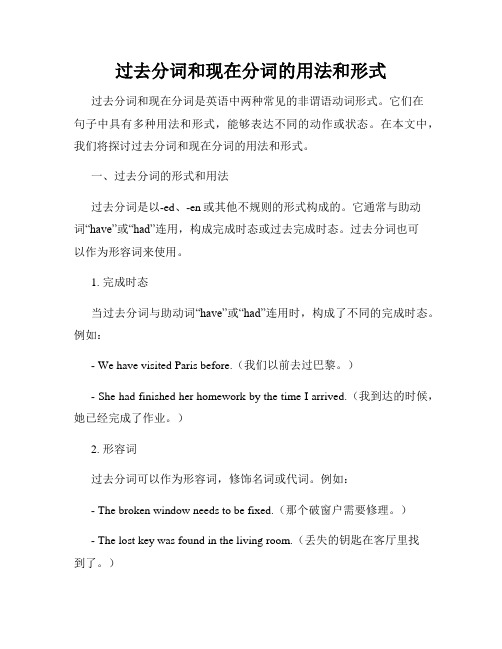
过去分词和现在分词的用法和形式过去分词和现在分词是英语中两种常见的非谓语动词形式。
它们在句子中具有多种用法和形式,能够表达不同的动作或状态。
在本文中,我们将探讨过去分词和现在分词的用法和形式。
一、过去分词的形式和用法过去分词是以-ed、-en或其他不规则的形式构成的。
它通常与助动词“have”或“had”连用,构成完成时态或过去完成时态。
过去分词也可以作为形容词来使用。
1. 完成时态当过去分词与助动词“have”或“had”连用时,构成了不同的完成时态。
例如:- We have visited Paris before.(我们以前去过巴黎。
)- She had finished her homework by the time I arrived.(我到达的时候,她已经完成了作业。
)2. 形容词过去分词可以作为形容词,修饰名词或代词。
例如:- The broken window needs to be fixed.(那个破窗户需要修理。
)- The lost key was found in the living room.(丢失的钥匙在客厅里找到了。
)二、现在分词的形式和用法现在分词是以-ing结尾的动词形式,常用于进行时态,或作为形容词和副词来使用。
1. 进行时态现在分词与“be”动词连用,构成了进行时态,表示正在进行的动作或状态。
例如:- He is studying for the exam.(他正在为考试复习。
)- They were playing basketball in the park.(他们在公园里打篮球。
)2. 形容词现在分词可以作为形容词,修饰名词或代词。
例如:- The running water is very clear.(流动的水非常清澈。
)- I saw a crying baby on the street.(我在街上看到一个哭泣的婴儿。
)3. 副词现在分词还可以作为副词,修饰动词或整个句子。
【高中英语】分词在句子中做定语的用法总结
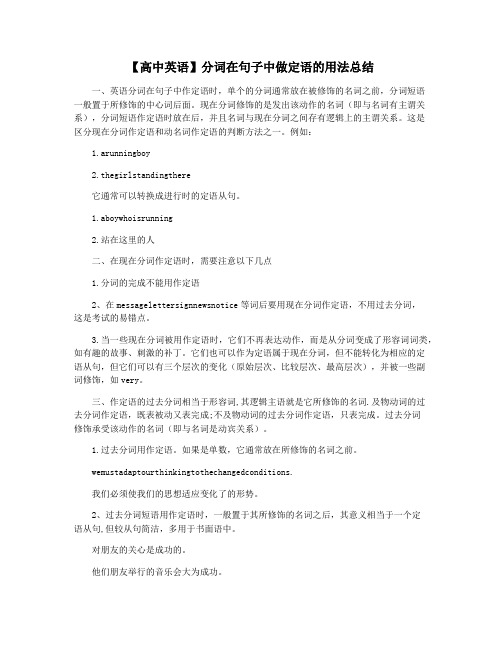
【高中英语】分词在句子中做定语的用法总结一、英语分词在句子中作定语时,单个的分词通常放在被修饰的名词之前,分词短语一般置于所修饰的中心词后面。
现在分词修饰的是发出该动作的名词(即与名词有主谓关系),分词短语作定语时放在后,并且名词与现在分词之间存有逻辑上的主谓关系。
这是区分现在分词作定语和动名词作定语的判断方法之一。
例如:1.arunningboy2.thegirlstandingthere它通常可以转换成进行时的定语从句。
1.aboywhoisrunning2.站在这里的人二、在现在分词作定语时,需要注意以下几点1.分词的完成不能用作定语2、在messagelettersignnewsnotice等词后要用现在分词作定语,不用过去分词,这是考试的易错点。
3.当一些现在分词被用作定语时,它们不再表达动作,而是从分词变成了形容词词类,如有趣的故事、刺激的补丁。
它们也可以作为定语属于现在分词,但不能转化为相应的定语从句,但它们可以有三个层次的变化(原始层次、比较层次、最高层次),并被一些副词修饰,如very。
三、作定语的过去分词相当于形容词,其逻辑主语就是它所修饰的名词.及物动词的过去分词作定语,既表被动又表完成;不及物动词的过去分词作定语,只表完成。
过去分词修饰承受该动作的名词(即与名词是动宾关系)。
1.过去分词用作定语。
如果是单数,它通常放在所修饰的名词之前。
wemustadaptourthinkingtothechangedconditions.我们必须使我们的思想适应变化了的形势。
2、过去分词短语用作定语时,一般置于其所修饰的名词之后,其意义相当于一个定语从句,但较从句简洁,多用于书面语中。
对朋友的关心是成功的。
他们朋友举行的音乐会大为成功。
3.过去,分词短语有时被用作不受限制的定语,通常在它们之前和之后加逗号。
他们举行了欢迎英雄的大会,到会的有五千多人。
用来修饰人的过去分词有时可以用来修饰非人类的事物。
高中英语知识点归纳分词的用法

高中英语知识点归纳分词的用法分词是英语语法中的一个重要知识点,它有着广泛的应用。
在高中英语学习中,掌握分词的用法对于学生的语言运用能力和阅读理解能力都有着极大的帮助。
本文将对高中英语中分词的用法进行归纳总结。
一、分词的定义分词是一种非常特殊的动词形式,它既有动词的特点,又具有形容词或副词的特点。
分词的形式有两种:现在分词(-ing形式)和过去分词(-ed形式)。
在句子中,分词可以作定语、表语、宾语补足语等。
下面将分别介绍这些用法。
二、现在分词的用法1.作定语现在分词可以修饰名词或代词,表示被修饰词的性质、特征或状态。
例如:a running horse(一匹奔跑的马)、a smiling child(一个微笑的孩子)。
2.作表语现在分词可以作为连系动词的表语,表示主语的特征或状态。
例如:She is amazing(她很令人惊叹)。
3.作状语现在分词可以修饰谓语动词,表示动作的方式、原因或时间。
例如:He left, crying(他边哭边离开)。
三、过去分词的用法1.作定语过去分词可以修饰名词或代词,表示被修饰词的性质、特征或状态。
例如:a broken window(一个破损的窗户)、a written report(一份书面报告)。
2.作表语和状语过去分词也可以作为连系动词的表语,表示主语的特征或状态。
例如:The door was closed(门是关着的)。
过去分词还可以修饰谓语动词,表示动作的结果。
例如:She arrived, tired(她疲惫地到达了)。
四、分词的完成时态在句子中,分词还可以和助动词have、has、had连用,形成完成时态。
一般现在分词加上have/has构成现在完成分词,过去分词加上had构成过去完成分词。
例如:Having finished his homework, he went to bed(做完作业后,他去睡觉了)。
五、现在分词和过去分词的区别现在分词和过去分词的区别主要在于时间和动作性质。
英语分词短语用法总结
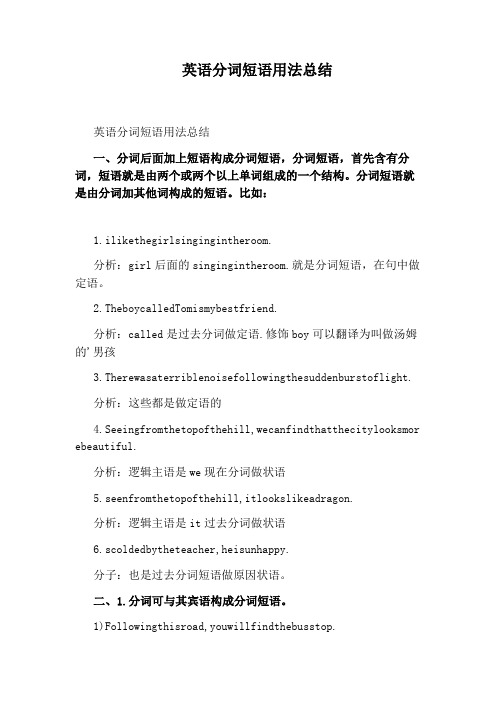
英语分词短语用法总结英语分词短语用法总结一、分词后面加上短语构成分词短语,分词短语,首先含有分词,短语就是由两个或两个以上单词组成的一个结构。
分词短语就是由分词加其他词构成的短语。
比如:1.ilikethegirlsingingintheroom.分析:girl后面的singingintheroom.就是分词短语,在句中做定语。
2.TheboycalledTomismybestfriend.分析:called是过去分词做定语.修饰boy可以翻译为叫做汤姆的'男孩3.Therewasaterriblenoisefollowingthesuddenburstoflight.分析:这些都是做定语的4.Seeingfromthetopofthehill,wecanfindthatthecitylooksmor ebeautiful.分析:逻辑主语是we现在分词做状语5.seenfromthetopofthehill,itlookslikeadragon.分析:逻辑主语是it过去分词做状语6.scoldedbytheteacher,heisunhappy.分子:也是过去分词短语做原因状语。
二、1.分词可与其宾语构成分词短语。
1)Followingthisroad,youwillfindthebusstop.要是沿着这条路走,你会找到车站。
(followingthisroad是分词短语。
)2)Doyouknowthegirlmakingpaperflowers?你认识做纸花的那个女孩吗?(makingpaperflowers是分词短语。
)2.介词及其宾语作修饰语,可与前面的分词构成分词短语。
1)Walkingalongthestreet,hesawabar.他在街上走时,他看到了一个酒吧。
(walkingalongthestreet 是分词短语。
)2)Beingcaughtintherain,hegotacold.由于被雨淋了,他感冒了。
英语分词的用法
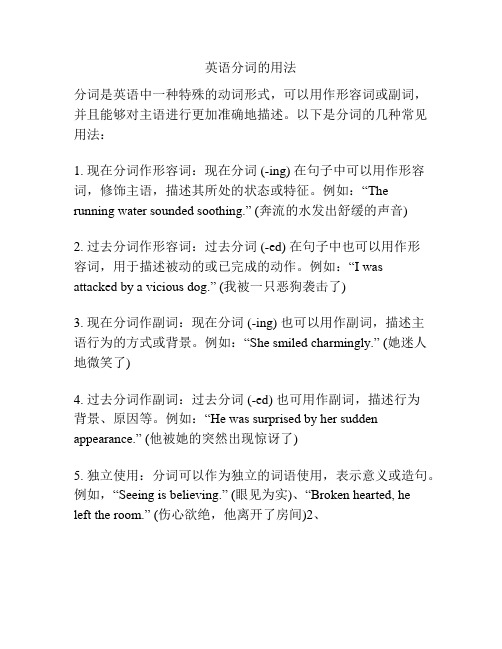
英语分词的用法
分词是英语中一种特殊的动词形式,可以用作形容词或副词,并且能够对主语进行更加准确地描述。
以下是分词的几种常见用法:
1. 现在分词作形容词:现在分词 (-ing) 在句子中可以用作形容词,修饰主语,描述其所处的状态或特征。
例如:“The running water sounded soothing.” (奔流的水发出舒缓的声音)
2. 过去分词作形容词:过去分词 (-ed) 在句子中也可以用作形
容词,用于描述被动的或已完成的动作。
例如:“I was attacked by a vicious dog.” (我被一只恶狗袭击了)
3. 现在分词作副词:现在分词 (-ing) 也可以用作副词,描述主
语行为的方式或背景。
例如:“She smiled charmingly.” (她迷人地微笑了)
4. 过去分词作副词:过去分词 (-ed) 也可用作副词,描述行为
背景、原因等。
例如:“He was surprised by her sudden appearance.” (他被她的突然出现惊讶了)
5. 独立使用:分词可以作为独立的词语使用,表示意义或造句。
例如,“Seeing is believing.” (眼见为实)、“Broken hearted, he
left the room.” (伤心欲绝,他离开了房间)2、。
初中英语知识点归纳分词的用法

初中英语知识点归纳分词的用法分词是英语中的一个重要语法现象,也是初中英语学习中的一个难点。
掌握分词的用法对于提高我们的英语水平非常有帮助。
本文将对初中英语中分词的用法进行归纳总结,以便同学们更好地掌握和运用。
一、分词的定义分词是动词的一种形式,它可以在句子中具有动词和形容词的双重功能。
根据其形式和用法的不同,分词可以分为现在分词和过去分词两种。
二、现在分词的用法1. 现在分词作主语现在分词可以作主语,常用于表示主动的动作或状态。
例句:Walking in the park is good for our health.(在公园散步对我们的健康有益。
)Playing games too much is not good for students.(玩游戏太多对学生不利。
)2. 现在分词作定语现在分词可以修饰名词或代词,充当定语。
例句:The book written by Mark Twain is very popular.(马克·吐温写的这本书非常受欢迎。
)She is a hard-working student.(她是一个勤奋的学生。
)3. 现在分词作宾语补足语现在分词可以作宾语补足语,用来描述或补充说明及物动词的动作。
例句:I saw him lying on the grass.(我看到他躺在草地上。
)She heard the news, leaving her in shock.(她听到这个消息后,震惊不已。
)4. 现在分词作状语现在分词可以作时间、原因、伴随等状语,用来修饰整个句子或主句。
例句:Feeling hungry, he decided to cook some noodles.(因为感到饿了,他决定煮点面条。
)Being tired, she went to bed early.(因为感到疲倦,她早早上床休息了。
)三、过去分词的用法1. 过去分词作定语过去分词可以修饰名词或代词,充当定语。
英语分词的用法
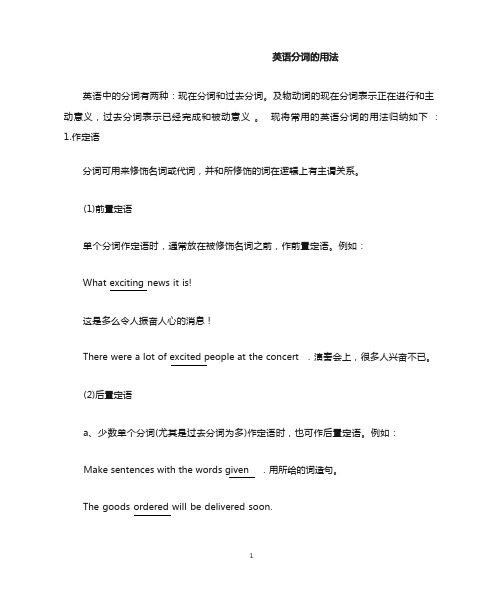
英语中的分词有两种:现在分词和过去分词。
及物动词的现在分词表示正在进行和主动意义,过去分词表示已经完成和被动意义。
现将常用的英语分词的用法归纳如下 : 1.作定语分词可用来修饰名词或代词,并和所修饰的词在逻辑上有主谓关系。
(1)前置定语单个分词作定语时,通常放在被修饰名词之前,作前置定语。
例如:What exciting news it is!这是多么令人振奋人心的消息 !There were a lot of excited people at the concert .演奏会上,很多人兴奋不已。
(2)后置定语a、少数单个分词(尤其是过去分词为多)作定语时,也可作后置定语。
例如:Make sentences with the words given .用所给的词造句。
The goods ordered will be delivered soon.The money left is far from enough.Many people are dubious about the announcement from the authorities concerned.b、单个分词作不定代词的定语时,要放在被修饰代词之后,作后置定语。
例如:Is there anything unsolved ?还有没解决的问题吗?There is something missing .有东西丢失了。
c、分词短语作定语时,要放在被修饰名词之后,作后置定语。
这时的分词短语相当于一个定语从句。
例如:Do youknow the old womansittingunder the tree ?( =Do youknow the oldwoman who is sitting under the tree ?)你认识坐在树下的那个老太太吗 ?There comes a girl dressed in red .( =There comes a girl who is dressed inred .)一个穿红衣服的女孩走过来了。
初中英语知识点归纳现在分词的形式与用法

初中英语知识点归纳现在分词的形式与用法现在分词是英语中一种非常常见的动词形式,它可以作为主语、宾语、定语、状语等。
了解并掌握现在分词的形式和用法对于学习英语语法和提高英语写作能力非常重要。
本文将对初中英语中常见的现在分词的形式和用法进行归纳总结。
一、一般现在分词的形式一般现在分词的形式:动词原形+ing。
如:playing、singing、dancing等。
二、现在分词作主语现在分词作主语时,常放在句首,并与谓语动词用逗号隔开。
1. 使用现在分词作主语可以表示正在进行的动作或状态。
例如:- Swimming is my favorite sport.(游泳是我最喜欢的运动。
)- Singing in the shower makes me happy.(在淋浴时唱歌使我快乐。
)2. 使用现在分词作主语还可以表示客观事实或普遍现象。
例如:- Smoking is harmful to your health.(吸烟对健康有害。
)- Learning a foreign language is important.(学习一门外语很重要。
)三、现在分词作宾语补足语现在分词作宾语补足语时,常紧跟在宾语之后。
例如:- I heard her singing in the next room.(我听到她在隔壁房间唱歌。
)- She saw him running towards the bus.(她看到他往公交车跑去。
)四、现在分词作定语现在分词可以用作定语修饰名词,一般位于被修饰词之前。
例如:- The smiling girl is my sister.(那个微笑的女孩是我的妹妹。
)- I could hear the running water from the river.(我可以听到河水的流动声。
)五、现在分词作状语现在分词可以作状语,在句中修饰主语、谓语或整个句子。
1. 现在分词作时间状语,表示动作发生的时间。
初中英语语法复习:分词的用法(分词作表语)
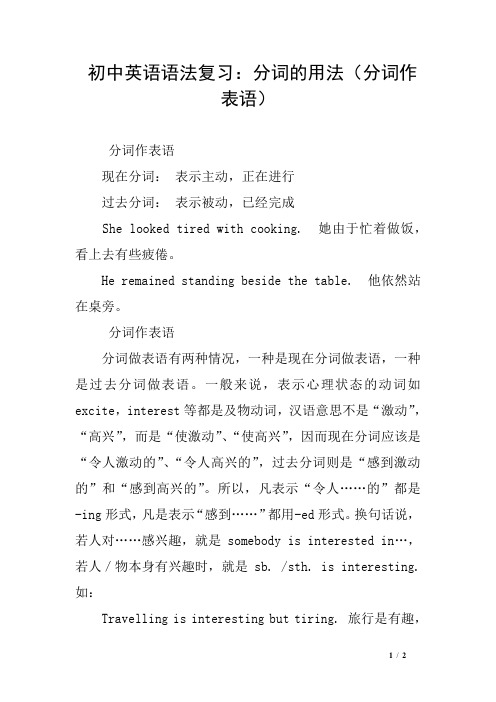
初中英语语法复习:分词的用法(分词作
表语)
分词作表语
现在分词:表示主动,正在进行
过去分词:表示被动,已经完成
She looked tired with cooking. 她由于忙着做饭,看上去有些疲倦。
He remained standing beside the table. 他依然站在桌旁。
分词作表语
分词做表语有两种情况,一种是现在分词做表语,一种是过去分词做表语。
一般来说,表示心理状态的动词如excite,interest等都是及物动词,汉语意思不是“激动”,“高兴”,而是“使激动”、“使高兴”,因而现在分词应该是“令人激动的”、“令人高兴的”,过去分词则是“感到激动的”和“感到高兴的”。
所以,凡表示“令人……的”都是-ing形式,凡是表示“感到……”都用-ed形式。
换句话说,若人对……感兴趣,就是somebody is interested in…,若人/物本身有兴趣时,就是sb. /sth. is interesting.如:
Travelling is interesting but tiring. 旅行是有趣,
1/ 2
但是使人疲劳。
The pupils will get confused if they are made to learn too much. 如果要学生学得太多,他们会感到糊涂的。
The argument is very convincing. 这个论点很令人信服。
They were very excited at the news. 听到这个消息,他们非常激动。
2/ 2。
英语分词短语用法总结
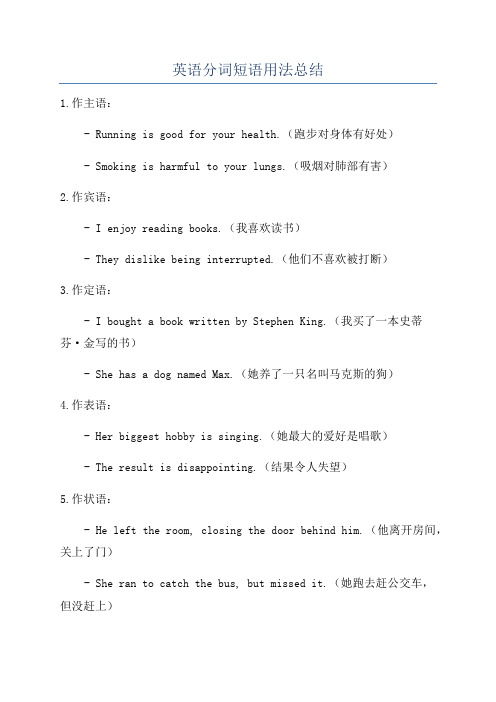
英语分词短语用法总结1.作主语:- Running is good for your health.(跑步对身体有好处)- Smoking is harmful to your lungs.(吸烟对肺部有害)2.作宾语:- I enjoy reading books.(我喜欢读书)- They dislike being interrupted.(他们不喜欢被打断)3.作定语:- I bought a book written by Stephen King.(我买了一本史蒂芬·金写的书)- She has a dog named Max.(她养了一只名叫马克斯的狗)4.作表语:- Her biggest hobby is singing.(她最大的爱好是唱歌)- The result is disappointing.(结果令人失望)5.作状语:- He left the room, closing the door behind him.(他离开房间,关上了门)- She ran to catch the bus, but missed it.(她跑去赶公交车,但没赶上)6.作补语:- I kept the window open to let in fresh air.(我把窗户开着让新鲜空气进来)- We found the door unlocked when we got home.(我们回家时发现门没有锁)7.作介词宾语:- They are interested in learning foreign languages.(他们对学习外语很感兴趣)- Are you afraid of flying?(你害怕乘飞机吗?)8.作形容词宾补:- She looked tired after the long journey.(长途旅行后,她看起来很累)- The cake tasted delicious.(蛋糕尝起来很美味)总的来说,英语分词短语可以在句子中起到多种作用,并有各自的语法用法。
高中英语分词的用法
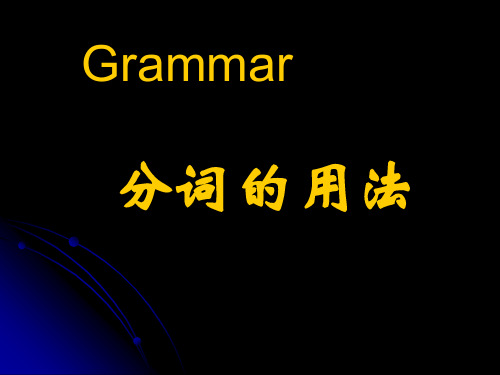
过去分词作定语
过去 分词作定语表示被动或完成,一个分词单词作定语往往放 在它所饰的词的前面, 但分词短语作定语则放在所修饰的词的 后面.
1. Look at the broken cup.
= Look at the cup which is broken.
*Laughing and talking, the children came into the classroom.
*现在分词短语 作伴随或方式状语 *不可改成相应状语从句
总结
• 分词做状语有以下四种形式:
}主动 • Doing……, …………
• Having done……, ………
}被动 • Done…….., ………
*The house( which was )built last yearwill be pulled down.
*The house( which is )being built will be a store.
3. A) The building __b_e_i_n_g__b_u_i_l_t now will be a restaurant . B) The building __t_o__b_e__b_u_i_lt__ next year will be a restaurant . C) The building ___b__u_il_t_______ last year is a restaurant. (build)
Seeing their teacher, the students stood up. *现在分词短语作( 时间状语 )
*现在分词动作的发出者是( 句子主语)
高中英语——分词的功能及用法.doc
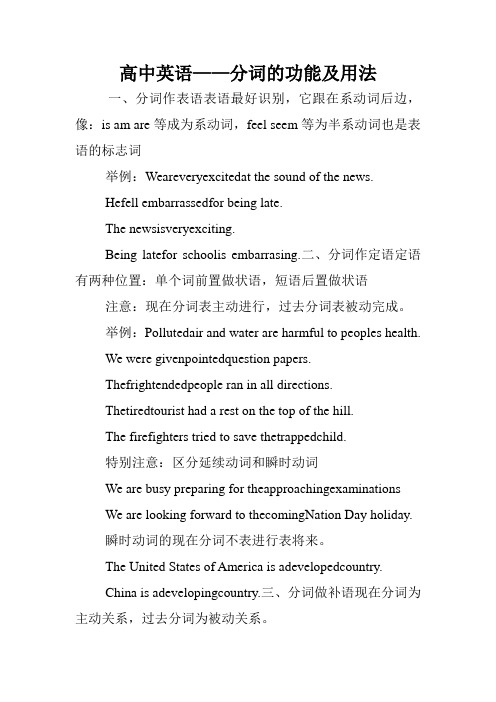
高中英语——分词的功能及用法一、分词作表语表语最好识别,它跟在系动词后边,像:is am are等成为系动词,feel seem等为半系动词也是表语的标志词举例:Weareveryexcitedat the sound of the news.Hefell embarrassedfor being late.The newsisveryexciting.Being latefor schoolis embarrasing.二、分词作定语定语有两种位置:单个词前置做状语,短语后置做状语注意:现在分词表主动进行,过去分词表被动完成。
举例:Pollutedair and water are harmful to peoples health.We were givenpointedquestion papers.Thefrightendedpeople ran in all directions.Thetiredtourist had a rest on the top of the hill.The firefighters tried to save thetrappedchild.特别注意:区分延续动词和瞬时动词We are busy preparing for theapproachingexaminationsWe are looking forward to thecomingNation Day holiday.瞬时动词的现在分词不表进行表将来。
The United States of America is adevelopedcountry.China is adevelopingcountry.三、分词做补语现在分词为主动关系,过去分词为被动关系。
举例:He found his mindplaying with other childrenon the playground.I had my electric bikerepairedyesterday.He left the toprunning.He always keeps the drawerlocked.分词短语做补语举例:She came home from work only to find her housebroken into.We found the bosssatisfied with our work.I saw the busfilled with passagers.I noticed herchatting on the phone.四、分词作状语分词作状语在主句前表:时间,原因,条件,让步。
中考英语复习之分词的用法有哪些

中考英语复习之分词的用法有哪些英语的语法的复习,特殊是动词的时态、语态以及在句子中的不同形式,与汉语有很大的区分。
英语语法学习从理论讲是程序性学问的学习。
下面是我给大家带来的中考英语复习之分词的用法,欢迎大家阅读参考,我们一起来看看吧!学校英语语法:分词作插入语其结构是固定的,意思上的主语并不是句子的主语。
generally speaking 一般说来talking of (speaking of) 说道strictly speaking 严格的说judging from 从…推断all things considered 从整体来看taking all things into consideration 全面看来Judging from his face, he must be ill. 从他的脸色看,他肯定是病了。
Generally speaking, dogs can run faster than pigs. 总的来说,狗比猪跑得快。
(speaking 并不是dogs 的动作)学校英语语法:分词作表语现在分词:表示主动,正在进行过去分词:表示被动,已经完成She looked tired with cooking. 她由于忙着做饭,看上去有些疲乏。
He remained standing beside the table. 他依旧站在桌旁。
学校英语语法:分词作补语通常在感官动词和使役动词之后,如:I found my car missing. 我发觉我的车不见了。
Ill have my watch repaired. 我想把我的手表修一下。
学校英语语法:分词作状语As I didnt receive any letter from him, I gave him a call.- Not receiving any letter from him, I gave him a call.由于没有收到他的信,我给他打了电话。
英语语法中的分词的解析
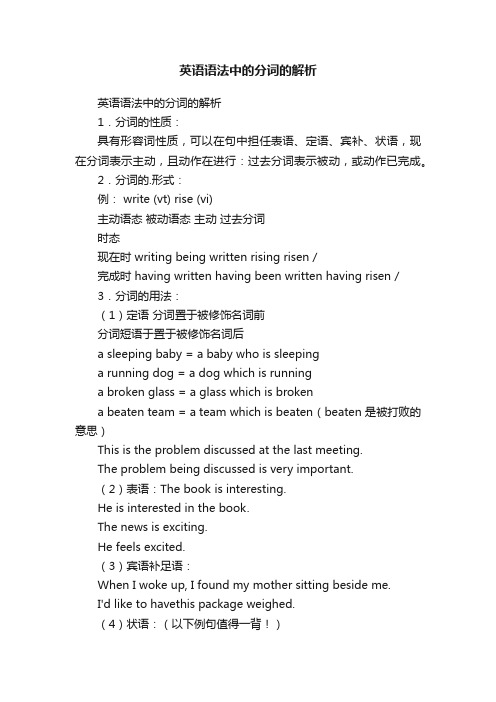
英语语法中的分词的解析英语语法中的分词的解析1.分词的性质:具有形容词性质,可以在句中担任表语、定语、宾补、状语,现在分词表示主动,且动作在进行:过去分词表示被动,或动作已完成。
2.分词的.形式:例: write (vt) rise (vi)主动语态被动语态主动过去分词时态现在时 writing being written rising risen /完成时 having written having been written having risen /3.分词的用法:(1)定语分词置于被修饰名词前分词短语于置于被修饰名词后a sleeping baby = a baby who is sleepinga running dog = a dog which is runninga broken glass = a glass which is brokena beaten team = a team which is beaten(beaten 是被打败的意思)This is the problem discussed at the last meeting.The problem being discussed is very important.(2)表语:The book is interesting.He is interested in the book.The news is exciting.He feels excited.(3)宾语补足语:When I woke up, I found my mother sitting beside me.I'd like to havethis package weighed.(4)状语:(以下例句值得一背!)① If you turn to the left, you'll find the station.→ Turning to the left, you'll find the station.② As I didn't receive her letter, I cal led her up by telephone.→ Not receiving her letter, I called her up by telephone.③ While I was walking to school yesterday morning, I met a friend.→ Walking to school yesterday morning, I met a friend.④ When she was asked it she had any bad habit, she answeredthat she was a heavy smoker.→ Asked if she had any bad habit, she answered that she was a heavy smoker.注意:在运用此类句型时主语前后要保持一致。
高考英语分词的用法

高考英语分词的用法分词作为英语语法中的一种非常重要的形式之一,经常出现在高考英语试卷中。
它具有多种用法和形式,包括现在分词、过去分词和分词短语。
下面将详细介绍高考英语中分词的用法和例句。
一、作主语分词可以作为句子的主语,强调行为的持续性和延续性。
常见的结构是“It/This/That is/was + 现在分词/过去分词”。
例句:1. Studying hard is important for students to achieve good grades.(现在分词作主语)2. Cooking dinner for the family was a daily routine for my mother.(过去分词作主语)二、作宾语分词作为句子的宾语,表明被动或完成的动作。
1. 情态动词+现在分词情态动词可以与现在分词结合,表示对过去或现在的怀疑、推测等。
例句:1. He must be studying in the library.(表示对他正在图书馆学习的推测)2. They could be waiting for the bus.(表示他们可能正在等公交车)2. 动词+不定式/现在分词有些动词后面可以接不定式或现在分词作宾语,但含义略有区别。
例句:1. I enjoy reading novels in my spare time.(不定式作宾语)2. She finished writing her report yesterday.(现在分词作宾语)三、作定语/状语分词可以作为定语修饰名词或作状语修饰动词、形容词等。
1. 现在分词作定语现在分词作为定语,修饰名词,表示主动或进行中的动作。
例句:1. The running water sounds refreshing.(现在分词修饰名词)2. The students standing in front won the first prize.(现在分词修饰名词)2. 过去分词作定语过去分词作为定语,表示被动、完成或说明状态。
英语中的分词

英语中的分词在英语中,分词(Participles)是一种动词的非限定形式,通常以-ing(现在分词)或-ed、-en、-t、-n(过去分词)结尾。
分词可以用作形容词,也可以用在一些复杂的动词时态中。
以下是关于分词的主要用法:●现在分词(Present Participle):1.以-ing结尾,如"playing," "reading," "walking"。
2.作为形容词使用,描述正在进行的动作或事物的特征。
例句:The playing children seemed happy.翻译:玩耍的孩子们似乎很开心。
3.用于进行时态(Present Continuous Tense)。
例句:She is reading a book.翻译:她正在读一本书。
●过去分词(Past Participle):1.过去分词的形式有多种,通常以-ed结尾,如"played," "talked";也可以是不规则的形式,如"broken," "written"。
2.作为形容词使用,描述已完成的动作或事物的状态。
例句:The broken window needs to be fixed.翻译:需要修理的破窗户。
3.用于完成时态(Present Perfect Tense, Past Perfect Tense)。
例句:They have eaten lunch already.翻译:他们已经吃过午餐了。
4.用于被动语态。
例句:The letter was written by Tom.翻译:这封信是汤姆写的。
分词在英语中也有其他一些用法,如独立分词、分词短语等。
分词的灵活运用可以使语言更富有表现力和变化。
英语分词的用法(一)

英语分词的用法(一)英语分词的用法什么是英语分词?分词是将一个长句子分成短语或单词的方法。
英语分词是英语中一个重要的语法概念,通过将一个句子分成可管理的部分,可以使读者更好地理解长句子的含义。
分词的作用•更好地理解长句子的含义•帮助语言学习者发掘句子的语法和结构,提高阅读和写作能力•使句子更清晰,更易读,更容易理解分词的几种形式1.现在分词:通常以 -ing 结尾,可以被用作形容词,表示正在进行的动作。
例如:The running water sounds soothing.(流水的声音非常舒缓)2.过去分词:通常以 -ed 结尾,可以被用作形容词,表示已经发生的动作。
例如:The broken vase needs to be fixed.(破碎的花瓶需要被修好)3.原形复合词:由动词和副词或介词组成的短语,可以作为形容词或副词。
例如:The well-known actor arrived at the party.(著名的演员来参加派对了)4.不定式:以“to” 开始的动词短语,可以作为名词、形容词或副词。
例如:To study English every day is important.(每天学习英语很重要)分词的应用1.作形容词:分词可用于描述人、物、事物等形容词的用法。
例如:The excited children ran to the playground.(兴奋的孩子们跑到操场上)2.作副词:分词可用于描述动作发生的方式和情况。
例如:Heleft the office, slamming the door behind him.(他离开办公室,狠狠地关上了门)3.作补语:分词可用于补充说明主语或宾语的情况。
例如:Ibecame interested in English after studying abroad.(我在国外留学后对英语产生了兴趣)4.作主语:分词可用于作为句子的主语。
英语分词的用法和区别对比
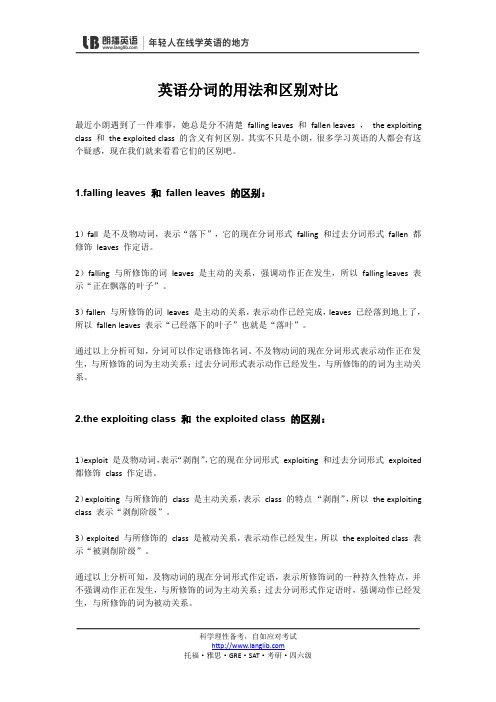
英语分词的用法和区别对比最近小朗遇到了一件难事,她总是分不清楚falling leaves和fallen leaves,the exploiting class和the exploited class的含义有何区别。
其实不只是小朗,很多学习英语的人都会有这个疑惑,现在我们就来看看它们的区别吧。
1.falling leaves和fallen leaves的区别:1)fall是不及物动词,表示“落下”,它的现在分词形式falling和过去分词形式fallen都修饰leaves作定语。
2)falling与所修饰的词leaves是主动的关系,强调动作正在发生,所以falling leaves表示“正在飘落的叶子”。
3)fallen与所修饰的词leaves是主动的关系,表示动作已经完成,leaves已经落到地上了,所以fallen leaves表示“已经落下的叶子”也就是“落叶”。
通过以上分析可知,分词可以作定语修饰名词。
不及物动词的现在分词形式表示动作正在发生,与所修饰的词为主动关系;过去分词形式表示动作已经发生,与所修饰的的词为主动关系。
2.the exploiting class和the exploited class的区别:1)exploit是及物动词,表示“剥削”,它的现在分词形式exploiting和过去分词形式exploited 都修饰class作定语。
2)exploiting与所修饰的class是主动关系,表示class的特点“剥削”,所以the exploiting class表示“剥削阶级”。
3)exploited与所修饰的class是被动关系,表示动作已经发生,所以the exploited class表示“被剥削阶级”。
通过以上分析可知,及物动词的现在分词形式作定语,表示所修饰词的一种持久性特点,并不强调动作正在发生,与所修饰的词为主动关系;过去分词形式作定语时,强调动作已经发生,与所修饰的词为被动关系。
英语语法 什么是分词短语
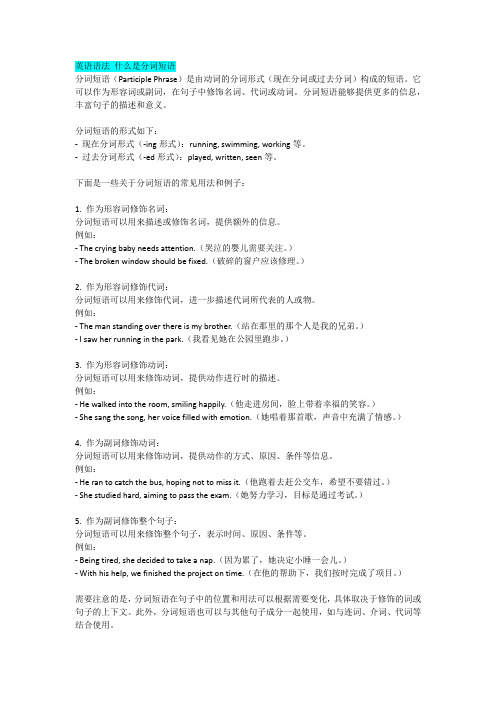
英语语法什么是分词短语分词短语(Participle Phrase)是由动词的分词形式(现在分词或过去分词)构成的短语。
它可以作为形容词或副词,在句子中修饰名词、代词或动词。
分词短语能够提供更多的信息,丰富句子的描述和意义。
分词短语的形式如下:-现在分词形式(-ing形式):running, swimming, working等。
-过去分词形式(-ed形式):played, written, seen等。
下面是一些关于分词短语的常见用法和例子:1. 作为形容词修饰名词:分词短语可以用来描述或修饰名词,提供额外的信息。
例如:- The crying baby needs attention.(哭泣的婴儿需要关注。
)- The broken window should be fixed.(破碎的窗户应该修理。
)2. 作为形容词修饰代词:分词短语可以用来修饰代词,进一步描述代词所代表的人或物。
例如:- The man standing over there is my brother.(站在那里的那个人是我的兄弟。
)- I saw her running in the park.(我看见她在公园里跑步。
)3. 作为形容词修饰动词:分词短语可以用来修饰动词,提供动作进行时的描述。
例如:- He walked into the room, smiling happily.(他走进房间,脸上带着幸福的笑容。
)- She sang the song, her voice filled with emotion.(她唱着那首歌,声音中充满了情感。
)4. 作为副词修饰动词:分词短语可以用来修饰动词,提供动作的方式、原因、条件等信息。
例如:- He ran to catch the bus, hoping not to miss it.(他跑着去赶公交车,希望不要错过。
)- She studied hard, aiming to pass the exam.(她努力学习,目标是通过考试。
英语分词的用法解析
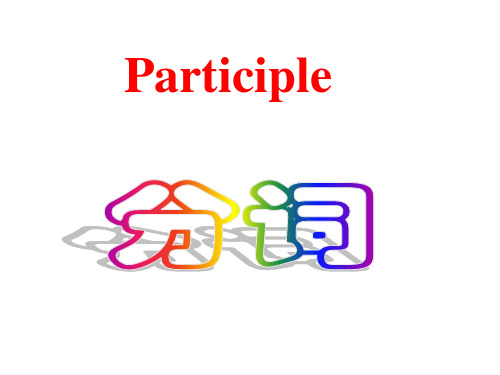
(When he was) asked why he didn’t do it, he began to cry.
e.g. 2. Given more time, I’ll catch up with you. 过去分词作条件状语相当于条件状语从句
Participle
现在分词: 表示动作是主动的和正在进行 过去分词: 表示动作是被动的和完成
分词的结构
一般式 完成式
现在分词 形式
doing
having done
过去分词 形式
done
having been done
分词在句中可作的成分
1. 作表语 2. 作定语 3. 作宾语补足语 4. 作状语
表示方式和伴随情况时可以转换为一个并列的谓语 成分。
The teacher entered the classroom (and he was followed) by a group of student.
过去分词作状语时, 为了使意义更加明确,也可以在pp. 前加上对应的连词when, as, if 等等.
三级链接
1. The new airpot (build) _________ now is 30 miles away from the city and is much larger than old one.
答案: being built. 空格处需用现在分词的 被动语态来表示被动和正在进行的动作, 且在句中作定语,修饰先行词airport.
The stolen car was found by the police last week.
- 1、下载文档前请自行甄别文档内容的完整性,平台不提供额外的编辑、内容补充、找答案等附加服务。
- 2、"仅部分预览"的文档,不可在线预览部分如存在完整性等问题,可反馈申请退款(可完整预览的文档不适用该条件!)。
- 3、如文档侵犯您的权益,请联系客服反馈,我们会尽快为您处理(人工客服工作时间:9:00-18:30)。
1. When asked why he didn’t do it, he began to cry. 2. If given more time, I’ll catch up with you. 3. As / Because born and brought up in the village, he knows a lot of people there. 4. Although defeated many times, they continue to fight.
• P59 依次分析每句话中,分词作什么成分: 1. 定语 2. 原因状语 3. 定语 4. 宾补 5. 伴随状语 6. 原因状语
I. Past participle used as attributes (定语)
1.位置: 单个分词位于名词前,短语则在名词后, 被过去分词所修饰的名词,就是该分词的逻辑 主语。 The stolen car was found by the police last week. The speaker answered all the questions raised by the audience.
e.g. 2. Given more time, I’ll catch up with you. 过去分词作条件状语相当于条件状语从句
(If I am) given more time, I’ll catch up with you. e.g. 3. Born and brought up in the village, he knows a lot of people there. 过去分词作原因状语相当于原因状语从句 (Because he was) born and brought up in the village, he knows a lot of people there.
考点:分词的进行式表示动作正在进行
• 试比较: 1. The problem discussed yesterday has something to do with daily life. (表示完成) 2. The problem being discussed now has nothing to do with daily life. (表示正在进行)
2.作用---相当于一个定语从句
(1)Is there anything planned for tonight ? =Is there anything that has been planned for tonight? (2)The book, written in1957, tells the struggle of the miners. =The book, which was written in 1957, tells the struggle of the miners.
试比较: I saw her come into the classroom. (强调看见进入教室这个动作的全过程) I saw her coming into the classroom. (强调看见进入教室这个动作正在发生的瞬 间。) I saw her taken out of the classroom. (强调动作take和主语her之间的被动关系。)
三级链接
The policeman kept his eyes ____ on the screen of the computer to identify the criminal’s footprints. (2006年12月真题) A. fixed B. fixing C. being fixed D. to fix 答案: A。 本题考查分词做宾补, eyes和 fix之间是被动关系,故选A。
三级链接
1. The new airpot (build) _________ now is 30 miles away from the city and is much larger than old one. 答案: being built. 空格处需用现在分词的 被动语态来表示被动和正在进行的动作, 且在句中作定语,修饰先行词airport.
When visited (当有人夜里来访)at night , ____________ you must make sure the visitor really your friend.
e.g. 4. Defeated many times, they continue to fight. 过去分词作让步状语相当于让步状语从句
(Although they had been) defeated many times, they continued to fight. e.g.5. The teacher entered the classroom, followed by a group of students.
4. with / without+宾语+宾补(过去分词)
当这一动词(及物动词)和with后的宾语在逻辑上 是被动关系,而且该动作已经发生过了,动词必须 用过去分词。 1. Do you know the man with his hair tied back? 你看见那个扎辫子的男人没? 2. The fellow stood there with his hands crossed . 这个家伙两手交叉,站在那里。 3. The peasants have a good harvest with all the crops got in . 庄稼都收割了,农民们有了一个好收成。 4. With the homework finished, I went to bed. 做完作业,我就上床睡觉了。
注意:带有连词的过去分词结构相当于一个省略句, 省略的部分为主语+be的相应变化形式.
注意: 1) 现在分词与过去分词作状语时的区别
选择现在分词还是过去分词,关键看主句的 主语。 如分词的动作是主句的主语发出,分 词就选用现在分词,反之就用过去分词。
When visiting _______________London (夜里参观伦敦)at night, you are a bit like in a dream.
IV. Past participle used as the Adverbial(状语)
过去分词作状语相当于状语从句。 e.g. 1. Asked why he didn’t do it, he began to cry. 过去分词作时间状语相当于时间状语从句 (When he was) asked why he didn’t do it, he began to cry.
2. 表“感觉, 心理状态”的动词:
see, hear, find, feel, think, watch, notice + object(宾语) + p.p 3. 使役动词和类似使役动词的动词: make, get, have, keep ,leave, etc.+ p.p
考点:过去分词, 不定式, 现在分词作宾补的 区别。 三者与宾语逻辑上都是主谓关系, • 但过去分词强调他们之间的被动关系, • 不带to的不定式强调动作发生的全过程, • 现在分词强调他们之间的主动关系,正在 • 进行。
2. The Olympic Games, _______ in 776 B.C.,did not inlude women players until 1912. A. plays B. to play C. playing D. played 答案: D。 本题考查非谓语动词。分词短语 做后置定语,与所修饰的词有被动或动宾 的关系,只能用过去分词。
II. Past participles used as predictive(表语)
1. 过去分词作表语,表示主语所处的状态, 其逻辑主语就是句子的主语。 The window is broken. The inner gate was locked. She was greatly excited. 2. 与现在分词作表语的区别: 现在分词:主语的特征或性质,“令人…”,有主动意 思。
表示方式和伴随情况时可以转换为一个并列的谓语 成分。
The teacher entered the classroom (and he was followed) by a group of student.
过去分词作状语时, 为了使意义更加明确,也可以在pp. 前加上对应的连词when, as, if 等等.
考点:现在分词通常用来修饰物;过去分词通常
用来修饰人或与人感情色彩、面部表情相关的词。
• an interesting story; • a surprised look an exciting football match; a group of excited football fans a shocking news; a shocked face
常见的这类此有: interesting — interested encouraging — encouraged delighting—delighted disappointing—disappointed pleasing—pleased puzzling—puzzled satisfying—satisfied surprising—surprised wo表示动作是主动的和正在进行 过去分词: 表示动作是被动的和完成
分词的结构
现在分词 形式
一般式 完成式 doing having done
过去分词 形式
done having been done
分词在句中可作的成分
1. 作表语 2. 作定语 3. 作宾语补足语 4. 作状语
三级链接
1. We saw the thief ________(catch) by the police. 答案: caught. 2. People found the water________.(pollute) 答案:polluted 3. Have you heard a pop song________(sing) in Japanese? 答案: sung 4. He had his watch __________ (repair). 答案:repaired.
